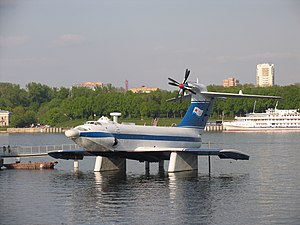A-90 Orlyonok
| A-90 "Orlyonok" | |
|---|---|

| |
| A-90 "Orlyonok" in Moscow | |
| Role | Ekranoplan |
| Manufacturer | Central Hydrofoil Design Bureau |
| Designer | Rostislav Evgenievich Alexeyev |
| First flight | 1972 |
| Introduction | 1979 |
| Retired | 1993 |
| Primary user | Soviet Navy |
| Number built | 4 |
The A-90 Orlyonok (Russian: Орлёнок, English: "Eaglet") is a Soviet ekranoplan (a ground effect vehicle) that was designed by Rostislav Evgenievich Alexeyev of the Central Hydrofoil Design Bureau.
The A-90 uses ground effect to fly a few meters above the surface. The Russians classify it as Ekranoplan Class B - it can achieve an altitude of 3,000 m (9,800 ft), placing it between Class A - which is limited to ground effect, and Class C, which exploits the ground effect only during take-offs and landings and otherwise functions as a typical airplane.
History
The Soviet Navy command of the 1960s was very interested in a fast military transport capable of carrying a large payload. The Central Hydrofoil Design Bureau was one of the organizations working on this top secret project, about which little was known until the fall of the Soviet Union.
Chief Designer R.E. Alexeyev designed several prototypes in the 1960s. At the start of the 1970s, Alexeyev designed a medium-sized Ekranoplan to be used as a military transport. The new vehicle was named "Orlyonok" ("Eaglet"). The first flying unit (S-21) was initially tested on the Volga River in the autumn of 1972, and the next year dismantled and transported to the Caspian Sea for continued testing. In 1975 the S-21 crashed during testing, later proved to be due to a deficiency in the alloy used for the hull. A different alloy was used in all subsequent units built.
Development and design
The Orlyonok was designed as a transport and also as a beach assault vehicle. Unlike other Soviet Ekranoplan designs, the Orlyonok was amphibious and was equipped with wheels for beaching and land based takeoffs.
The layout of the engines on the Orlyonok was unusual and a testament of the special needs of such an unconventional aircraft. Mounted in the top of the tail, it featured a massive Kuznetsov NK-12 turboprop, the most powerful turboprop ever made, which provided cruise power. The nose of the aircraft mounted two turbofan engines with the intakes on top of the nose and the exhaust along the side of the fuselage, the thrust of these engines being vectored under the wings to produce PAR thrust (increased lift and extra propulsion) for takeoff. Under cruise conditions and in ground effect, the front engines could be shut off since their power was unnecessary to keep the aircraft aloft; this also minimized intake of water, salt and low flying birds.
Both takeoff and landing were assisted with large span-length flaps that greatly increased lift and could capture PAR thrust for increased air pressure. Water landings were assisted with a hydro-ski that extended out of the belly of the craft below the main wings.
The front end of the Orlyonok was hinged behind the radome and the whole assembly could open sideways to speed disembarkation of the infantry it carried, or of a BTR armoured personnel carrier. The Orlyonok had a built in folding ramp that allowed it to load and unload vehicles with no external support.
There were plans to resume production of the Orlyonok. The craft were to have been built in Petrozavodsk.[1]
Production
Overall only four units were built :
- 1 Non-flying unit for static testing, scrapped.
- S-21 completed in 1972, accident in 1975, rebuilt as S-23 in 1978, then lost during another accident in 1992.
- S-25 completed in 1979, retired 1993.
- S-26 completed in 1980, retired 1993.
Operators
Specifications (A-90)

Data from [citation needed]
General characteristics
- Crew: 6
- Capacity: 150 personnel / 28,000 kg (61,729 lb)
- Length: 58.1 m (190 ft 7 in)
- Wingspan: 31.5 m (103 ft 4 in)
- Height: 16.3 m (53 ft 6 in)
- Wing area: 304 m2 (3,270 sq ft)
- Max takeoff weight: 140,000 kg (308,647 lb)
- Powerplant: 1 × Kuznetsov NK-12MK turboprop engine, 11,033 kW (14,795 shp) mounted at the fin / tailplane junction
- Powerplant: 2 × Kuznetsov NK-8-4K turbofan engines, 103 kN (23,000 lbf) thrust each in the nose
- Propellers: 8-bladed contra-rotating constant-speed propeller
Performance
- Maximum speed: 400 km/h (250 mph, 220 kn)
- Range: 1,500 km (930 mi, 810 nmi)
- Service ceiling: 3,000 m (9,800 ft)
Armament
- Guns: 2 x 12.7 mm machine guns in twin dorsal turrets
See also
- Lun-class ekranoplan
- Boeing Pelican (concept; never prototyped or built)
External links
- FAS.org
- Short summary on Soviet Ekranoplans
- The Alexeev Bureau (now a public company) page in English, with a color photo of the A-90 Ekranoplan
- An article in Russian about Lun and Orlyonok ekranoplans
- Register article
- A-90 Orlyonok on Google Maps
- (in English) All Orlan Class Ekranoplans - Complete Ship List
- Teel, George "Case study of Wing in Ground Effect with XFLR5: the A-90 Orlyonok (Орлёнок) Ekranoplan" - MAE 6226 (5 May 2015) George Washington University
